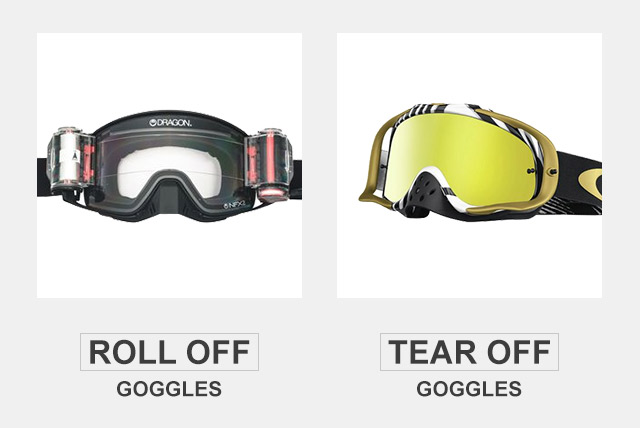
Stupid worthless goggles!
This sound like you riding on a hot day, rainy day, or muddy day? Better yet, this sound like you on just about any day you ride? A common cause of frustration for riders is goggles fogging up or just getting dirty, even when it's not raining out, which only serves to obstruct your vision.
Most riders learn to work through minor visual impediments but even the seasoned pro can't find the finish line when it looks like they're riding in clouds or buried underground. Furthermore, if you go the cheap route, i.e. substandard goggles without adequate sweat protection, it's a matter of time before sweat trickles into your eyes causing enough stinging discomfort to force you to the side.
So what's the best way to enjoy a scenic ride through the woods or ensure complete visual acuity around the track for the length of a Moto? Several tricks exist but it first starts with the type of goggles.
First and foremost - DON'T RIDE WITHOUT GOGGLES.
It should be a no-brainer but even the directions on a hair dryer say not to use in a bathtub full of water. Yes, the cameras, every now and then, catch one of your favorite pro riders hauling through a mudder without goggles. When you get to that level, with thousands of dollars on the line and a possible Championship then go ahead and take your chances.
Now that we've cleared that up, when looking for goggles don't go cheap. That's not to say inexpensive goggles are cheap. If you're working within a budget then trust any of the big goggle manufacturers with industrywide respect. At the very least get goggles that feature:
- Anti-fog lens
- Some type of clever venting system
- Face foam - usually triple layer
- UV protection
The more you pay the more exciting features you'll get. However, even with all the technology incorporated into today's goggles, sometimes the environment still wins. So, up your game a bit and invest in goggles designed to counter the elements.
Goggles with Tear-Offs
If you're new to the dirt riding scene watch a race sometime and occasionally you'll see a rider run his hand across his goggles usually in mid-flight after a jump. He's pulling a tear-off which is like a fancy wiper blade for goggles. Tear-offs are thin see-through plastic liners that stretch across the front of goggles. When dirt and mud build up where you can't see anymore, grab a tear-off and it's like a set of new goggles on your head.
Zach Osborne wearing the tear-off goggle system
The plus side to tear-offs is you can stack 10 or even 20 tear-offs to use throughout a race. The downside is quite often you'll pull more than one and if you're in the middle of a race and need to see quickly, there's no time to be extra careful and pull off one, so you just grab whatever tab is available and pull sometimes at the expense of five or six new ones. Thus, you might go through your entire stack of tear-offs before the race ends. The expense isn't the worry - pretty cheap actually - it's running out of a clear view to the finish line.
Goggles with Roll-Offs
One way to fix the problem that tear-offs present in using more tear-offs than necessary is the roll-off system. This system is like how cameras used a roll of film before digital took over. On one side of your goggles is rolled-up clear film inside a canister and as needed you roll the new film across your field of vision on the goggles as the old film rolls into a canister equipped on the other side of your goggles.
Ryan Dungey wearing the roll-off goggle system
It sounds clunky but the major manufacturers have simplified the system so it works relatively flawlessly. However, the downside of the roll-off system is the time and necessary hand work to get new film across. When you're racing Moto and seconds count this is probably not the best method. Trail riders commonly use this system but it also comes with a steeper price tag.
Extra Tricks for Trouble Free Goggles
Sometimes the weather is just too much for the most adaptable set of goggles so if the mud is overwhelming or you just sweat profusely, especially on a hot day, you'll need reinforcements.
The foam padding around goggles provides comfort, serves as a dam for sweat and acts as an air filter. Like the oil-coated air filter in the dirt bike's engine, dab some baby oil around the outside (not the part that sticks to your face!) of the foam padding on those dry and dusty days to keep the grime out.
The anti-fog lens works...for a while. Then it stops working. So either use an anti-fog cleaner or wipe before riding or replace the old lens with a new dual lens which many riders find helps immensely.
For the heavy sweat days you can stick a Kotex or similar pad to the top inner foam. Yeah, that's right we said it. It works. Now, guys, as far as how you go about getting one well, we leave that to you to figure out. Godspeed.
Extending the length of the dirt bike helmet visor is a great way to keep muck of your face and can be done on the cheap. Since the visor on your helmet features a similar and complimentary shape to a goggle lens tape an old lens to the helmet visor as an added extension. You'll be surprised at how much another inch of coverage keeps your face and goggles free of debris. It's especially helpful if you ever need to remove your goggles during a race.
Trey Canard wearing the two sets of goggles system
Finally, if the double goggle method works for Trey Canard it can work for you. Wearing two sets of goggles is only necessary in a mud race when little is left to chance like fighting for the whole shot as mud coats you from head to boots. Riding with a pair of goggles over another pair offers the quickest and easiest technique to clear vision. Just be prepared to never find the first set.












